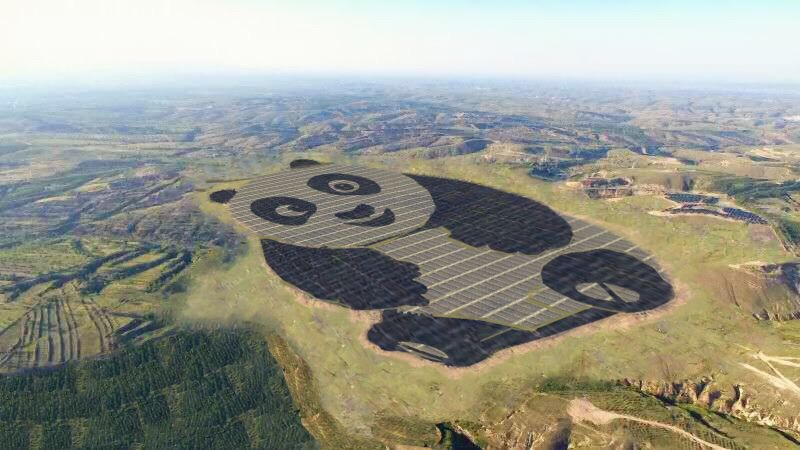The Chinese PV developer’s additions to its solar portfolio in the first six months of the year included projects it acquired, as well as 172.7 MW of capacity it built on its own. Its aggregate installed PV capacity reached 1.46 GW at the end of June, spread across 42 locations. Its cumulative, grid-connected solar capacity rose by 47% year on year in the first half, according to a statement to the Hong Kong stock exchange.
China’s Inner Mongolia region remains the company’s biggest market, with 270 MW installed. It was followed by Qinghai province, where the company has 200 MW connected to the grid across multiple locations. It also operates a single 200 MW installation in the Ningxia region.
In the first half, Panda Green finished building projects in Tibet, as well as others in Shanxi, Hebei and Zhejiang provinces. It also acquired 82.4 MW of operational PV capacity in the U.K., marking its first foray into overseas solar investment.
It claims it is now considering undisclosed investment opportunities in a range of markets throughout the world, including the U.S., Germany, France, Japan, the Philippines and Australia, as well as countries prioritized under the Chinese government’s Belt and Road development strategy. In May, the company signed an investment framework agreement with China Railway Construction Investment to jointly install 29.4 MW of solar in Sri Lanka.
Ground-mounted PV arrays account for roughly 97% of Panda Green’s grid-connected portfolio. However, it has also built a number of distributed-generation PV plants — primarily in China’s Jiangsu, Hebei, Zhejiang and Guangdong provinces — as well as installations integrated with agricultural facilities.
Panda Green recorded earnings before interest, tax, depreciation and amortization (EBITDA) of CNY 556 million, up 46% year on year, according to its unaudited results for the six months to the end of June. Total assets hit CNY 26.2 billion, from CNY 17.2 billion in the first six months of 2016, while total liabilities rose to CNY 12.4 billion, from CNY 9.4 billion a year earlier.
Revenue from sales of electricity, including tariff adjustments, hit CNY 690 million in the January-June period, up 52.65% on the year. The company’s projects in Inner Mongolia and Qinghai province together accounted for roughly 45% of total generation, with generation rising 8% and 5.8% year on year, respectively.
Panda Green — formerly known as United Photovoltaics — generated 1003.4 GWh of electricity in the six months to the end of June, adjusted slightly from the PV generation statistics it published earlier this summer, and up sharply from 611.2 GWh in the second half of 2016. It primarily attributed the increase in electricity generation to the expansion of its operational solar portfolio throughout the first half, as well as improvements in operating conditions.
However, it also acknowledged that the curtailment of solar from the Chinese grid remains an issue, particularly in Gansu province. It said that its projects in the province generated less electricity in the first half partly because it had to suspend operations from March to June as China State Grid finished installing an 800 kV ultra-high-voltage direct current (UHVDC) transmission line extending from Jiuquan, Gansu province, to Shaoshan, Hunan province. The UHVDC line went into operation in late June.
Throughout the first half, Panda Green continued to focus on efforts to diversify beyond solar into other renewables, which is the basis of its longer-term strategy. In August, it bought a 22% stake in two undisclosed developers that own 10 MW of solar capacity and a grid-connected 48 MW wind farm.
In the first half, Panda Green also bought a 75% stake in a renewables developer with a hydropower pipeline of more than 5 GW in Tibet and China’s Sichuan province, as well as 130 MW of grid-connected solar capacity. In addition, it said that it is mulling the purchase of a stake in an undisclosed wind developer.
In the first half of this year, Panda Green raised about CNY 7,117 million of financing for its projects, by issuing senior and medium-term notes, securing bank loans, signing financial leasing arrangements and placing new shares. Total net proceeds from new share placements reached HK$2,154 million ($275.3 million) in the first half, with Orix Asia Capital emerging as the company’s second-biggest shareholder this year by buying a 14.9% stake.
Throughout the January-June period, Panda Green also deepened its partnership with the United Nations Development Program (UNDP). In June, it connected its first 50 MW panda-shaped solar array to the grid in northern China in cooperation with the UNDP. The project, which includes monocrystalline and thin-film PV cells, is the first of many panda-shaped arrays that the two sides plan to jointly develop throughout the world over the next five years.
This content is protected by copyright and may not be reused. If you want to cooperate with us and would like to reuse some of our content, please contact: editors@pv-magazine.com.



By submitting this form you agree to pv magazine using your data for the purposes of publishing your comment.
Your personal data will only be disclosed or otherwise transmitted to third parties for the purposes of spam filtering or if this is necessary for technical maintenance of the website. Any other transfer to third parties will not take place unless this is justified on the basis of applicable data protection regulations or if pv magazine is legally obliged to do so.
You may revoke this consent at any time with effect for the future, in which case your personal data will be deleted immediately. Otherwise, your data will be deleted if pv magazine has processed your request or the purpose of data storage is fulfilled.
Further information on data privacy can be found in our Data Protection Policy.